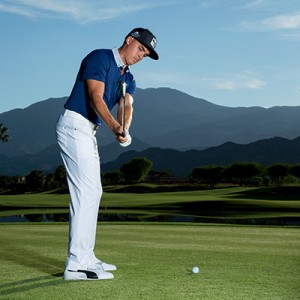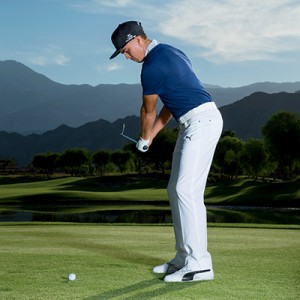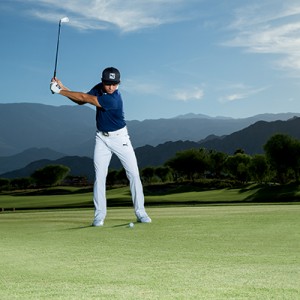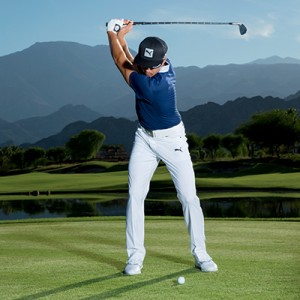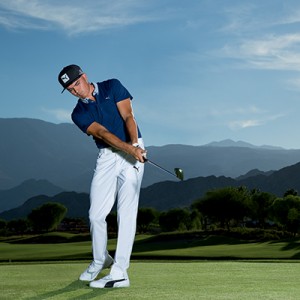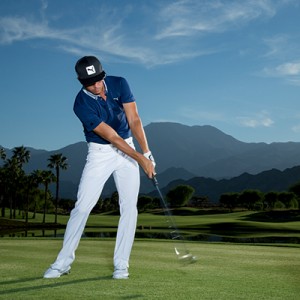Copy What I Worked On To Become A Better Iron Player
There’s only one way to play this game, and that’s to be fully committed on every shot. I’m sure you’ve heard that before, but that doesn’t make it any less true. Commitment doesn’t necessarily mean swinging harder. I think of it as everything moving with certainty. Big slices and big hooks happen when one part of the body gets tentative and then another part moves faster to compensate or manipulate.
As you’ve seen on the previous pages, I used to hang back with my upper body and throw my hands hard at the ball. That required a lot of timing, and my distance control with my irons was inconsistent. To get better, I needed to do something, so I teamed up with Butch Harmon. We cleaned up some bad habits and worked on a “full-body release,” which I’ll talk about later. It took me a while to get comfortable with the new move, but not too long; 2014 was the best season of my career.
Because I was making better contact, my long irons were flying higher and my short irons a hair lower, which helped me get more, and better, looks at birdie. Obviously, the changes were specific to me, but I think they get at fundamentals that every golfer should learn. For each change, Butch gave me a swing thought to rehearse in slow motion. What follows are the three thoughts that helped me most. Commit to these, and soon you’ll find yourself taking aggressive lines at the flag.
TAKEAWAY: TURN THE TOE UP
In my old takeaway, the clubface pointed at the ball for too long. There was this initial tension as my shoulders turned early while the club slowly dragged back, putting the clubface in a shut position. To fix this, my slow-motion rehearsal thought was the toe of the club makes the first move. When the toe rotates up to begin the swing, it syncs my wrist hinge with my shoulder turn right from the start. Another way to think of this is, the forearms make the first move: They rotate until the toe points to the sky [right]. It’s a matter of preference. Either thought works equally well and produces a really fluid takeaway. Here’s the most important drill I practised: I stop my takeaway when the club gets parallel with the ground. At that point, I check that the shaft falls perfectly along my toe line [left]. This means that from my view, the butt of the club is on the tip of my right shoe and points at my target. It means I’m “on plane.” This drill gave me so much confidence that I made it my waggle. I rehearse it once with smooth rhythm, return the club to address, then swing. Another thing Butch and I worked on: At address, keep your chin off your neck. Standing tall with a proud chin creates room for the shoulders to turn back and through.
BACKSWING: STAY CONNECTED
I used to suffer the same tendency that affects a lot of amateurs: My arms kept going back after I completed my shoulder turn. When the arms get disconnected from the trunk muscles like this, the club goes past parallel and can cause a bunch of issues. The grip might bounce around in your hands, and you’re going to have to find a way to re-sync your arms with your chest on the downswing. If you don’t sync them, you end up flipping your wrists at the ball to save the shot. So to keep everything unified going back, my slow-motion rehearsal thought was, I’m holding an umbrella on my backswing. As in, I stop going back the moment I feel the shaft points straight up and down like an umbrella [right]. In reality, the club travels much farther. But this is what I, and the other over-swingers out there, need to feel to deliver the club to a classic position at the top with the shaft parallel to the ground [left]. At the beginning, when the umbrella thought wasn’t always working, Butch told me to pretend I was Steve Stricker. Strick probably has the most quiet wrist hinge on tour. For golfers who can get overly wristy, Strick’s simple, straightarm action is another great image.
IMPACT: ALL TOGETHER
On the downswing, I used to hang back on my right side and throw my arms out and away from my body to hit the ball. My short irons would fly way high and on off-days go all over the place. I mentioned earlier how I want to make a full-body release. This means my hands and wrists are passive at impact. My chest covers the ball, and I feel that my arms, trunk, hips and legs (just about every ounce of me except my hands and wrists) are moving together to release the club [right]. This tip is more psychological than physical. Getting all of your body to swing in unison is actually pretty natural, but committing your mind is easier said than done when you’re on the course with trouble all around. But trust it. It’s usually when we try to guide a shot that we miss it big. As for mechanical guidance, my slow-motion rehearsal thought was, Keep the clubhead in line with my hands and chest past impact. I’d stop to check this all the time [left]. If I saw the clubhead left of my hands here, it meant my wrists had broken down and I flipped. I needed moves I could trust, and that’s what I have now.
With Max Adler

